The Proceedings of the 11th Prefectural Oversight Committee Meeting for Fukushima Health Management Survey was released on June 4, 2013. Below is the translation of the thyroid ultrasound examination, preceded by a summary and a quick analysis of the results.
The original Japanese results for the thyroid ultrasound examination are found here.
The official English translation is found here.
Previous survey results can be found here.
PDF of this post is found here.
*****
The official English translation is found here.
Previous survey results can be found here.
PDF of this post is found here.
*****
This report covers the thyroid ultrasound examination results for Fiscal Year Heisei 23 (FYH23 or H23 here) or FY2011 as well as Fiscal Year Heisei 24 (FYH24 or H24 here) or FY2012. It offers more information than previous reports, as in breakdown by municipalities. However, it fails to correlate findings with estimated individual exposure doses, a point repeatedly brought up at the post-committee meeting press conferences, especially in regards to the cancer cases. Previously, the Committee always insisted on privacy protection so as not to reveal even the residing municipality of subjects, let alone the exposure dose. In this respect, the municipality information offered at this time, in a way, may be construed as an improvement.
For the H23 results, additional 2,188 subjects who were examined in H24, from municipalities eligible for the H23 examination (the H23 municipalities), were added to the total reported in the last report which can be viewed here:
With this addition, the percentage of children with thyroid ultrasound abnormalities increased slightly for H23, from 35.8% (13,645 out of 38,114) to 36.3% (14,632 out of 40,302).
For the H24 results, 39,099 subjects were added to the previous report from the H24 municipalities, increasing the percentage of children with thyroid ultrasound abnormalities from 44.2% (41,946 out of 94,975) to 45.3% (60,681 out of 134,074).
Altogether, 43.2% (75,313 out of 174,376) of Fukushima children tested so far have thyroid ultrasound abnormalities.
In H25, 158,783 children from 34 municipalities, that is, the H25 municipalities, will undergo the initial examination.
The most recent results show that with time the overall rate of abnormalities appears to be increasing. The H23 municipalities will have follow-up examinations when the full-scale survey begins in H26 or FY2014. A question arises as to whether this follow-up is soon enough, especially when considering the progression of thyroid abnormalities in the H24 municipalities.
Moreover, a municipality such as Iwaki City, which was in the path of the heavy radioactive plume on March 15, 2011, just began the initial examination, and we don’t have a full picture of their results. In fact, Iwaki City was included in the thyroid dose monitoring, along with Iitate Village and Kawamata Town, in late March 2011, where the thyroid dose was determined, as mentioned here:
Also, Koriyama City produced 442 subjects eligible for secondary examinations from 50,805 who underwent the initial examination. Koriyama City being the most populous city in Fukushima Prefecture, a higher number of subjects with the B assessment, eligible for secondary examination, might not be unreasonable. However, the second most populous city, Fukushima City, had 263 subjects eligible for secondary examination out of 46,367 who underwent the initial examination. (228 of 263 actually underwent the secondary examination, 56 had biopsies, and 9 are suspected of having malignancy). Compared to this, Koriyama City’s 442 appears disproportionate. Moreover, only 5 of 442 have completed the secondary examination as of May 27, 2013, and 2 of the 5 are suspected of having malignancy. This seems ominous, considering how many have not even begun the secondary examination. Incidentally, Koriyama City is known to have numerous hot spots, and the appeal from the collective evacuation trial was recently turned down by the judge although the judge did admit radiation exposure may have a potential for serious health risks for children in Koriyama City.
The results of biopsy have been the center of intense interest at the press conference and also by general public. There were 12 cases, out of 205 eligible for secondary examination, suspected of malignancy upon biopsy and cytological examination in H23, and 16 cases, out of 935 eligible for secondary examination, in H24.
It should be noted that in H23 only 166 out of the 205 eligible actually underwent the secondary examination, and 82 had biopsies, resulting in 12 suspected/confirmed cases of malignancy: 8 had surgeries and one was found to have a benign nodule and 7 had papillary thyroid cancer, the most common form of thyroid cancer in general as well as due to radiation exposure, for instance, from the Chernobyl accident. There were 39 subjects who never underwent the secondary examination. As of May 27, 2013, 160 of the 166 completed the secondary examination. There are also 9,635 from the H23 municipalities who have not undergone the initial examination.
In H24, 255 of 935 eligible actually underwent the secondary examination. 223 of 255 completed the secondary examination, and 63 had biopsies, leading to 16 suspected/confirmed cases of malignancy: so far only 5 had surgeries and all 5 turned out to be papillary thyroid cancers. It should be noted that for the H24 municipalities there are nearly 700 more subjects who await secondary examination. There are also 30,896 who have not undergone the initial examination.
The last part of the report is an attachment from the Ministry of the Environment thyroid survey (MOE survey) results, which have been officially translated here:
Results from this MOE survey have been widely circulated as a proof that the Fukushima results are not any different from three other prefectures selected for the survey and thus the thyroid abnormalities being discovered are merely the screening effect and the thyroid cancers are nothing other than latent cancers discovered early with no relation to radiation exposure. However, it might not be reasonable to compare the two sets of data when the operator variabilities might affect the ultrasound assessment even using the same machine and also because the sample selection might be biased in the MOE survey.
*****
Note:
H23 refers to Heisei Year 23, which is the same as 2011.
FYH23 refers to Fiscal Year Heisei 23 which runs from April 1, 2011 through March 31, 2012.
H24 refers to Heisei Year 24, which is the same as 2012.
FYH24 refers to Fiscal Year Heisei 24 which runs from April 1, 2012 through March 31, 2012.
H25 refers to Heisei Year 25, which is the same as 2013.
FYH25 refers to Fiscal Year Heisei 25 which runs from April 1, 2013 through March 31, 2014.
*****
The Proceedings of the 11th Prefectural Oversight Committee Meeting for Fukushima Health Management Survey
Thyroid ultrasound examination
Implementation status of thyroid examination of Fukushima Health Management Survey
1 Initial examination (in-prefecture)
(1) Implementation status
① All municipalities scheduled for the H24 examination completed the examination according to the original plan. In addition, due to the efforts made, mentioned in the following page, the actual examination rate of about 82% was achieved. At the same time, Koriyama City and a part of Iwaki City were examined ahead of the original schedule.
② The H25 examination began on April 22, 2013. By the end of March, 2014, all those eligible in 34 municipalities (158,783 subjects) will be examined.
The H23 municipalities (13 municipalities designated as the evacuation zone by the government). As of March 31, 2013

The H24 municipalities (Iwaki City includes Hisanohama District only). As of March 31, 2013
The H25 municipalities As of May 10, 2013
※1 The top row shows the number of subjects who actually underwent the initial thyroid ultrasound examination. The middle row shows the rate of eligible subjects who were examined in each age group. The bottom row shows the proportion of subjects in each age group who actually underwent the initial thyroid ultrasound examination.
※2 The number of subjects, originally Fukushima residents, now residing outside Fukushima Prefecture, who came back to Fukushima Prefecture to undergo thyroid ultrasound examination.
● Age shown is the age as of March 11, 2011.
(2) Main efforts made towards enhancing the examination.
① Making certain the eligible subjects have opportunities for examination.
(i)Sending notification for the examination simultaneously to multiple municipalities sharing the living space. Also sending the latest examination schedule to those who have not undergone the examination in order to offer multiple opportunities for examination.
(ii)Conducting examination in school settings for students.
② Making sure the quality of the examination is maintained.
(i)Ensuring the support of thyroid specialists in and outside Fukushima Prefecture by widely publicizing the need for cooperation.
(ii)Ensuring the quality of set standard by offeing examination conducted by thyroid specialists, etc.
③ Accelerating the implementation of the thyroid ultrasound examination.
(i)Ensuring large venues that allow examination of 700 to 800 subjects per day in order to finish the initial examination ahead of the schedule.
④ Preparing the examination center inside Fukushima Prefecture.
(i)Conducting workshops for physicians and technicians in order to enhance the examination system inside Fukushima Prefecture.
2 Initial examination (out-of-prefecture)
(1) Implementation status
① Thyroid ultrasound examinations were started at facilities outside Fukushima Prefecture beginning on November 1, 2012.
② Notices for the initial examination held at examination facilities outside Fukushima Prefecture have been sent to the eligible subjects who were not able to undergo the examinations in the H23 eligible municipalities as well as the H24 eligible municipalities except for Koriyama City and Miharu Town.
③ Notices were sent on May 29, 2013, to the eligible subjects from Koriyama City and Miharu Town who have not undergone the examination.
④ Notices for the out-of-prefecture examination are being sent to the eligible subjects who have not undergone the examination, as they are identified in the order of municipalities which already conducted the examination.
The H23 municipalities for in-prefecture examination As of March 31, 2013 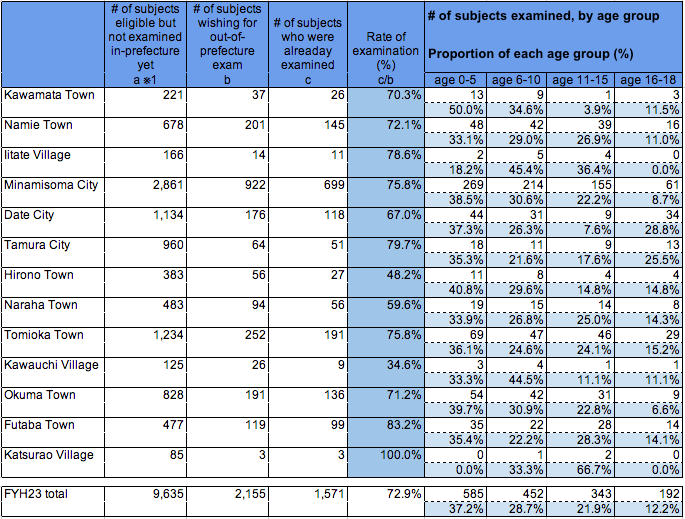
※1 The number of notices sent to the eligible subjects who have not undergone examinations at their respective municipalities.
● Those who have not undergone the examination may be examined either inside or outside Fukushima Prefecture.
● Age shown is the age as of March 11, 2011.
The H24 municipalities for in-prefecture examination As of March 31, 2013 
The H23/H24 municipalities for in-prefecture examination As of March 31, 2013 
H25 out-of-prefecture examination implementation status (from April 1 to May 16, 2013)
※1 The number of notices sent to the eligible subjects who have not undergone examinations at their respective municipalities.
● Those who have not undergone the examination may be examined either inside or outside Fukushima Prefecture.
● Age shown is the age as of March 11, 2011.
(2) Main efforts made towards enhancing the examination.
① Currently there are agreements made with 76 examination facilities nationwide (Attachment 2: Refer to page ②-13 of the original report in Japanese), and the expansion of the examination system outside Fukushima Prefecture is planned.
② Fukushima Medical University is sending the examination staff to prefectures with a large number of evacuees, such as Niigata and Yamagata Prefectures.
3 Initial examination results summary
(Summaries of results by municipalities are found in Attachments 3 and 4).
(1) Summary of H23 and H24 results
As of March 31, 2013
※1 ”Total number of subjects whose results have been finalized” refers to the total number of subjects who were examined at examination facilities inside and outside Fukushima Prefecture and whose results have been finalized.
※2 Includes the 2,188 subjects who were examined in H24 and whose results have been finalized. 
(For reference) The number of subjects categorized by nodules/cysts and their sizes in H23 and H24.

① Explanation of assessment classification
(i) A: (A1) No nodules or cysts found.
(A2) Nodules 5.0 mm or smaller or cysts 20.0 mm or smaller.
(ii) B: Nodules 5.1 mm or larger or cysts 20.1 mm or larger.
(iii) C: The condition of the thyroid gland warrants an immediate secondary examination.
② Explanation of the assessment results
(i) A1 and A2 will be observed until the next round of the examination beginning on and after H25 (FY2014).
(ii) B and C assessments will undergo secondary examination.
(iii) Some A2 cases might be considered B if the condition of the thyroid gland warrants secondary examination.
(2) H24 examination results: by age and sex
As of March 31, 2013
※1 Age groups are based on ages as of March 31, 2013.
● Refer to Attachment 5 for the H23 examination result detail by municipalities.
(3) Detailed results (H24 examination: nodules)
① Total results for nodules by presence/absence and size of nodules
Total results:
● Of 134,074 who were examined in FYH24, 1.2% (1.0% in H23) of 1,593 had nodules.
● Of 1,593 who had nodules, 922, or 0.7% (0.5% in FYH24) had nodules 5.1 mm or larger.
In addition, of these 922 mentioned above, 635 had nodules between 5.1 mm and 10.0 mm, comprising 68.9% (67.0% in FYH23) of 922 requiring secondary examination.
● 287 had nodules larger than 10.0 mm, comprising 0.21% (0.17% in FYH23).
(4) Detailed results (H24 examination: cysts)
① Total results for cysts by presence/absence and size of cysts
※1 Assessment classification based on the size of the cysts alone.
※2 The reason the size group “〜3.0 mm” is put together with “No cysts present” in the proportion is because in ordinary medical practice cysts smaller than 3.0 mm are treated as no cysts.
Total results:
● Of 134,074 who were examined in FYH24, 44.6% (35.6% in FYH23) of 59,865 had cysts.
Of these, 35,428 had cysts 3.0 mm or smaller, which are considered not to be cysts in ordinary medical practice.
● 24,437 had cysts larger than 3.1 mm, comprising 18.2% (16.8% in FYH24) of the total.
● More female had cysts 3.1 mm or larger (male 43.9% and female 56.1%: male 43.2% and female 56.8% in H23).
4 Secondary examination
(1) Implementation status
① Subjects eligible for secondary examination are being seen at a specific proportion as the initial thyroid ultrasound examination is carried out. A system allowing for a more rapid secondary examination was structured, so that the secondary examination can be carried out along with the initial examination.
H23 eligible municipalities (implementation status as of May 27, 2013)
H24 eligible municipalities (implementation status as of May 27, 2013)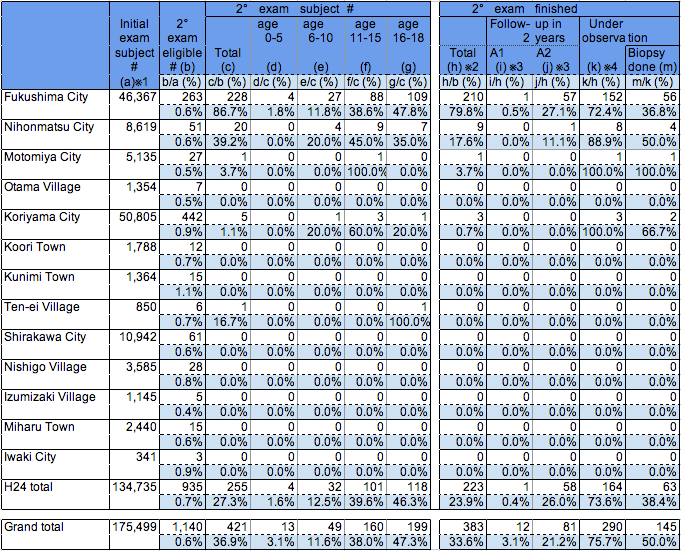
※1 (a) denotes a total of all subjects examined both inside and outside Fukushima Prefecture.
※2 (h) does not include the subjects who underwent blood and urine tests and biopsy who have not received the examination results.
※3 (i) and (j) will be followed up in the full-scale examination beginning in April 2014.
※4 (k) denotes subjects who will be followed up in approximately 6 months to one year using regular health insurance.
● Secondary examination requires multiple visits for testing such as blood and urine tests as well as for reporting of the results.
(2) Number of first visits per month (for subjects from H23 as well as H24)
(3) Main efforts made towards enhancing the examination.
① When lumps (nodular lesions) etc. have been found in the initial thyroid ultrasound examination, secondary examinations will be conducted at Fukushima Medical University, including detailed ultrasound, blood and urine tests, and biopsy if needed.
② A2 assessments which, based on the condition of thyroid gland, might warrant secondary examinations will be reclassified as B assessments and undergo secondary examinations.
③ Those who require urgent clinical assessments will be given priorities for secondary examinations.
④ Results of secondary examination are to be directly explained to the subjects and parents in detail and with adequate time.
⑤ Expansion of secondary examination will be attempted based on the schedule below.
(4) H24 municipalities: Secondary examination schedule (draft)
(5) Secondary examination results summary
② Age and sex distribution of 28 cases confirmed or suspected of maligancy based on biopsy.
③ Results of secondary examination by municipalities in H23 and H24. (As of May 27, 2013)
Results of secondary examination by municipalities in H23.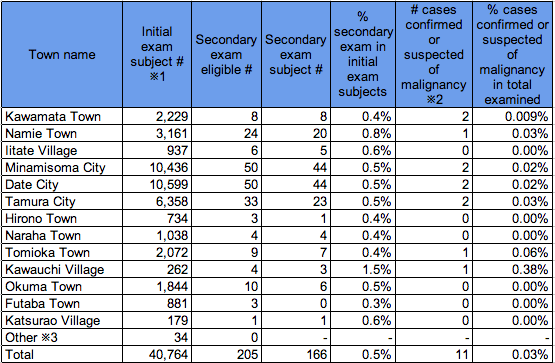
※1 Initial examination subjects include the subjects who underwent either in-prefecture or out-of-prefecture examinations.
※2 Does not include one case suspected of malignancy upon biopsy and found to be benign after surgery.
※3 “Other” includes subjects from outside the municipalities designated as the evacuation zone by the government but underwent thyroid ultrasound examination at schools.
Results of secondary examination by municipalities in H24.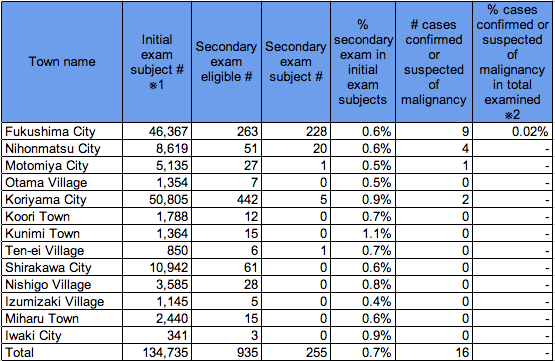
※1 Initial examination subjects include the subjects who underwent either in-prefecture or out-of-prefecture examinations.
※2 Municipalities other than Fukushima City are in the early stage of the secondary examination. Due to the low rate of examination to date, the numbers are not displayed here.
● Those who require urgent clinical assessments will be given priorities for secondary examinations.
● Those who require urgent clinical assessments will be given priorities for secondary examinations.

(Attachment 3)
H23 municipalities: Thyroid examination detailed results (as of March 31, 2013) 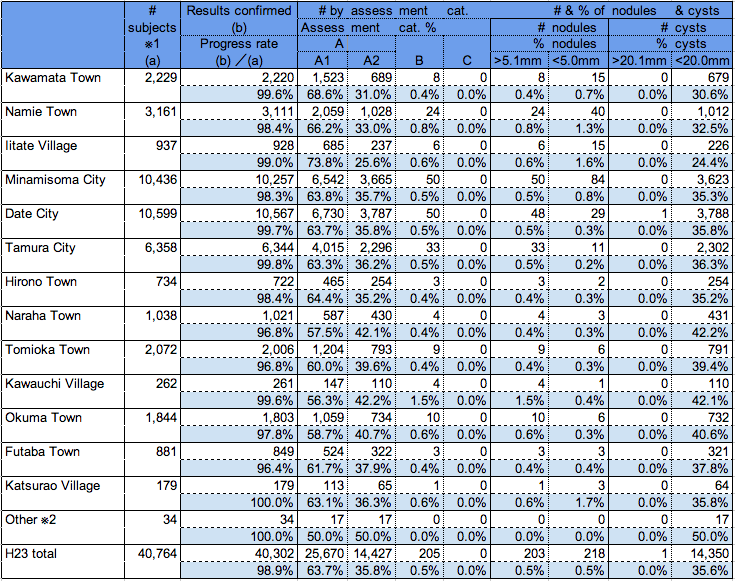
※1 Total number of subjects including in-prefecture and out-of-prefecture examinees.
※2 “Other” includes subjects from outside the municipalities designated as the evacuation zone by the government but underwent thyroid ultrasound examination at schools.
● It is difficult to make a simple comparison between municipalities, as each municipality has its own unique composition of the number of subjects and the age structure.
(Attachment 4)
H23 municipalities: Thyroid examination detailed results (as of March 31, 2013) 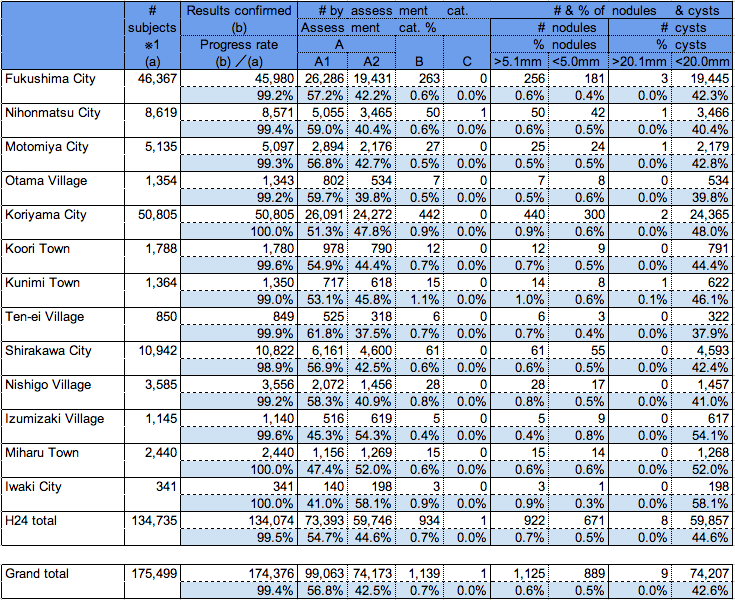
※1 Total number of subjects including in-prefecture and out-of-prefecture examinees.
● It is difficult to make a simple comparison between municipalities, as each municipality has its own unique composition of the number of subjects and the age structure.
(Attachment 5)
(1) H23 municipalities: In-prefecture examination results by age and sex
As of March 31, 2013
※1 Age group shown refers to the age as of March 11, 2011.
Note 1: These revised results include 2,188 children who were examined in H24.
(2) Total results for nodules by presence/absence and size of nodules
※ Assessment classification based on the size of the nodules alone.
(3) Total results for cysts by presence/absence and size of cysts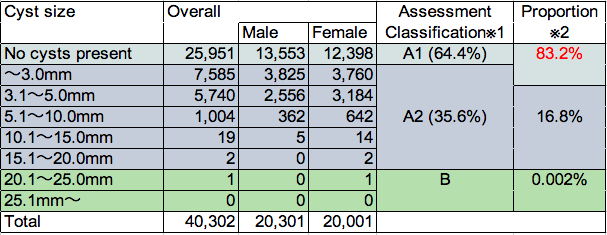
※1 Assessment classification based on the size of the cysts alone.
※2 The reason the size group “〜3.0 mm” is put together with “No cysts present” in the proportion is because in ordinary medical practice cysts smaller than 3.0 mm are treated as no cysts.

